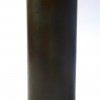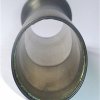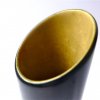Gynaekologie |
||
Ferguson's Speculum |
||
|
Zum Erfinder "designed by Sir William Fergusson (1808-1877)" (Science Museum). Dem widerspricht folgender Artikel: "Robert Fergusson who was the first Professor of Obstetrics and Gynaecology at King’s College Hospital, London introduced a straight tubular glass speculum. This instrument was initially made of metal only and later modified with glass mirrored inside and several layers of gum-elastic coat outside" (Ibrahim I Bolaji, Consultant Obstetrician and Gynaecologist; Olubusola Amu, Specialist Registrar; Rashmi Sinha, Staff Grade. Departments of Obstetrics & Gynaecology, Diana, Princess of Wales Hospital, Scartho Road,. in: The Gynaecological speculum - past, present and future". Der britische Arzt und Historiker Alban Doran (1849-1927) bringt gute Gründe vor, keinen Arzt, sondern einen Techniker als Erfinder anzusehen. In einem Artikel "Fergus(s)on's Speculum, in: The British Medical Journal, 11 march 1916 S. 397" beschreibt er ihn als "a dealer in St. Thomas's Street, S.E., at the entrance of St. Bartholomew's Hospital". Da Doran in diesem Hospital gearbeitet hatte, hatte er besagten Techniker vermutlich noch persönlich gekannt ... https://europepmc.org/articles/PMC2347106/pdf/brmedj07039-0035a.pdf Alexis Peck schreibt, dass sich Ferguson 1822 in London etabliert hatte.
Zu den Exponaten Wir stellen zwei Specula n. Fergus(s)on vor, beide aus England importiert (Verkäufer: Frank Scott-Tomlin 42 Selworthy House, Sedgemoor Road, Bath, Avon BA2 5NZ UK): A) Verspiegeltes Speculum aus Glas: "a tubular glass with mirrored interior and outside black coating: 14 cm ( 5 1/2 "). E. Bennion p.134" (Accoucheurs Antique). "The speculum has a mirrored interior. Light could be reflected inside the vagina to allow internal examination once the speculum was inserted. It has an elastic gum covering. The speculum was made in London by surgical instrument maker Simpson" (Science Museum "Brought to life").
B) Speculum aus Bakelite, mit nicht näher beschriebenem Kunststoffüberzug innerhalb des Rohres, stammt von der Fa. Arnold & Sons. "A cylindrical vaginal speculum. Circa 1850s. Bakelite outer, biege inner lining. 13 cm (5 1/4")" (Accoucheurs Antique) "The outer shell is of bakelite and the inner face has a much paler coating (presumably also bakelite) to allow more light to enter the tube. It is stamped on the inner side of the bell-shaped end with PATENT. ARNOLD & SONS" "Arnold was established in Smithfield, London in 1819 and traded as Arnold until 1857 becoming Arnold and Son and then Sons in 1866. It continued to trade under that name until 1923 when it was bought by John Bell & Croyden Ltd which in turn was brought by Savoury & Moore in 1928". Arnold & Sons, Katalog von 1876, 1879, 1886, 1895, 1902. |







